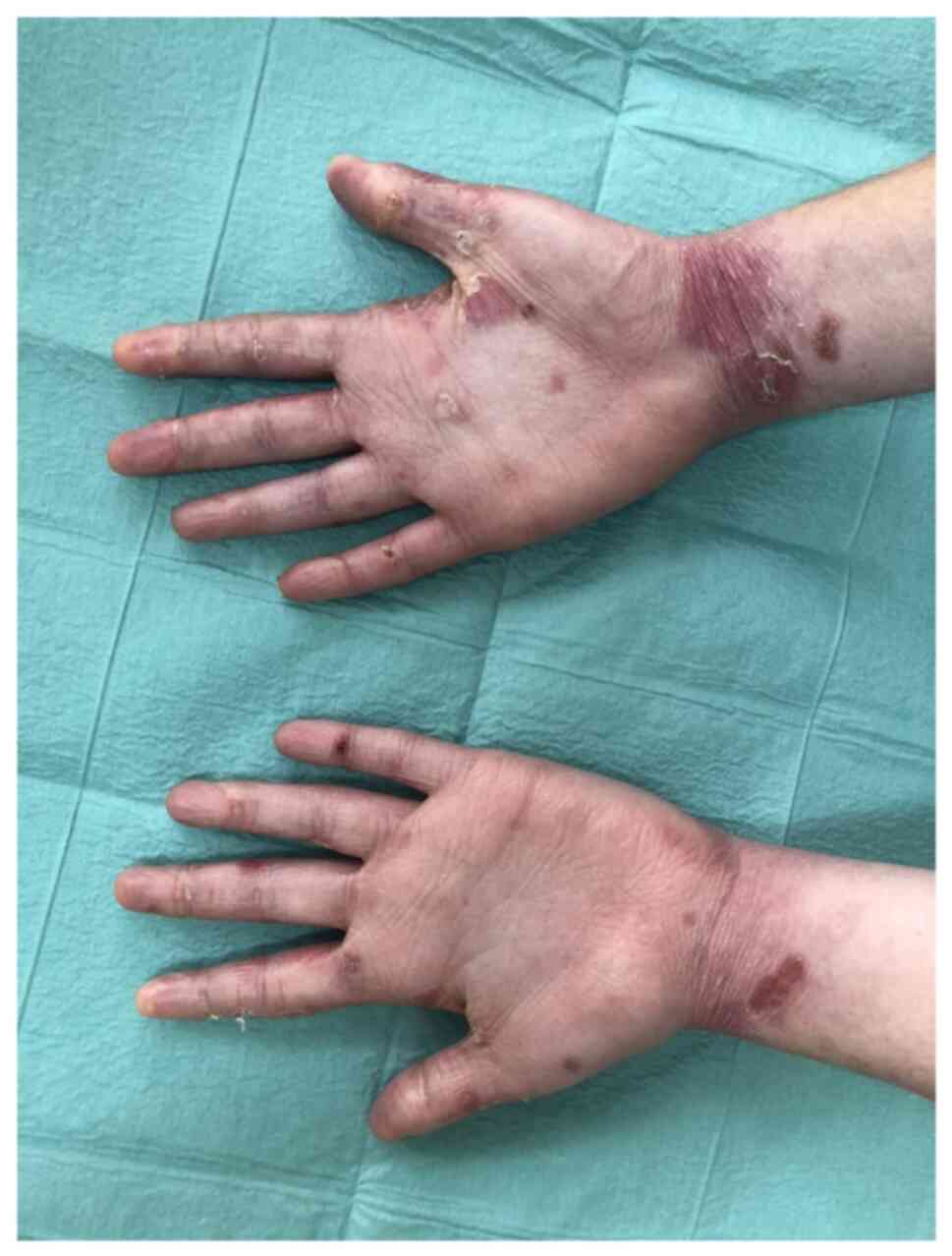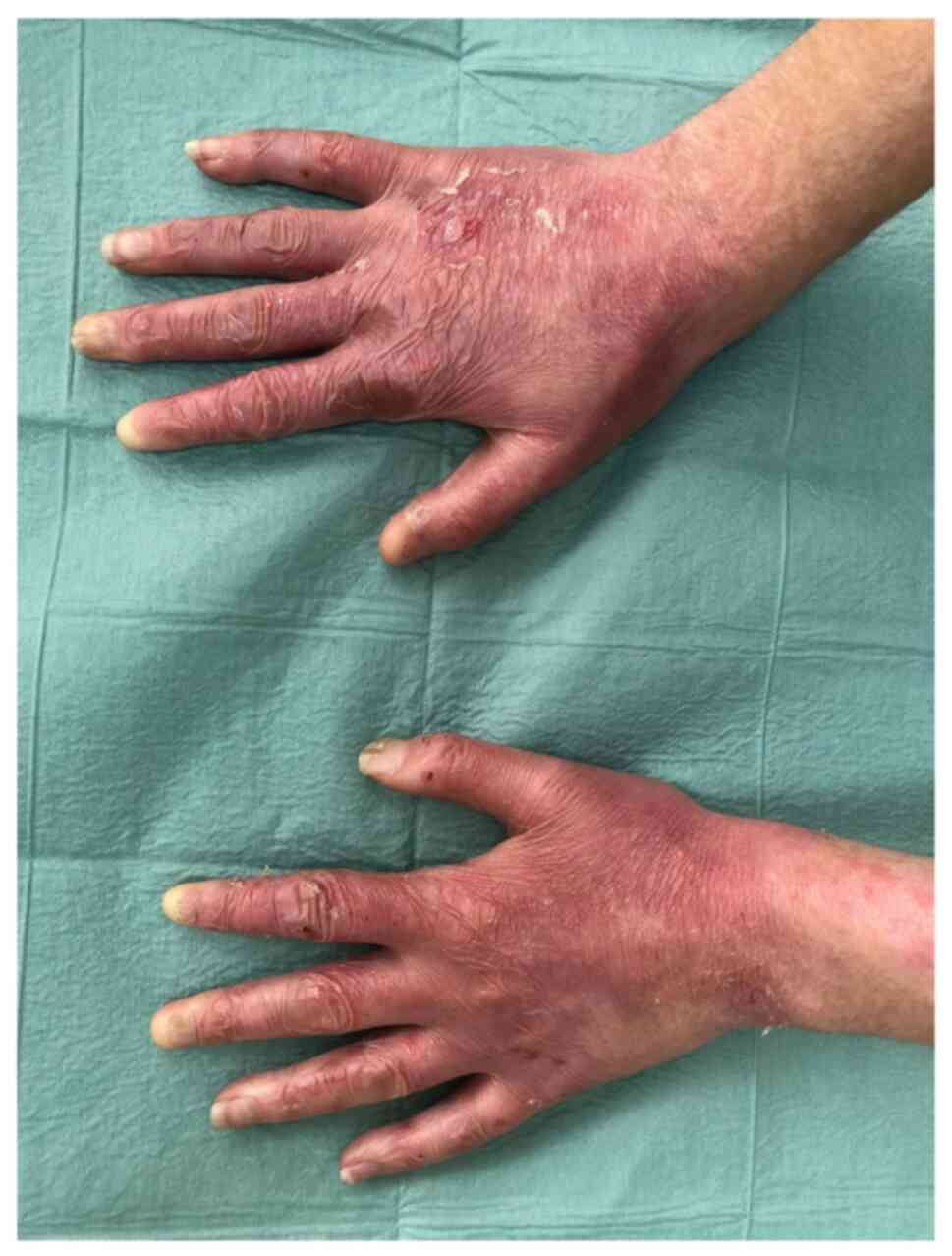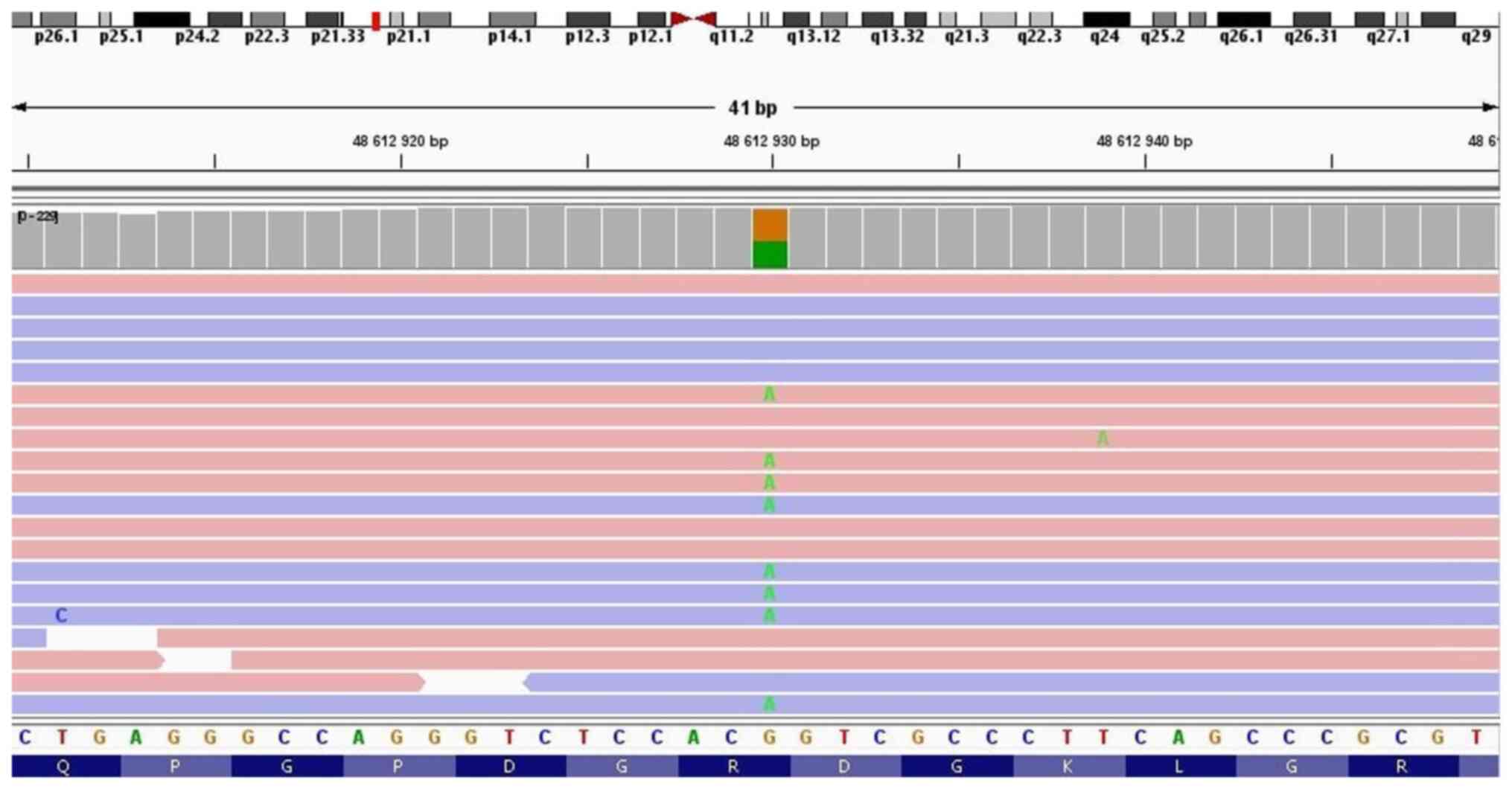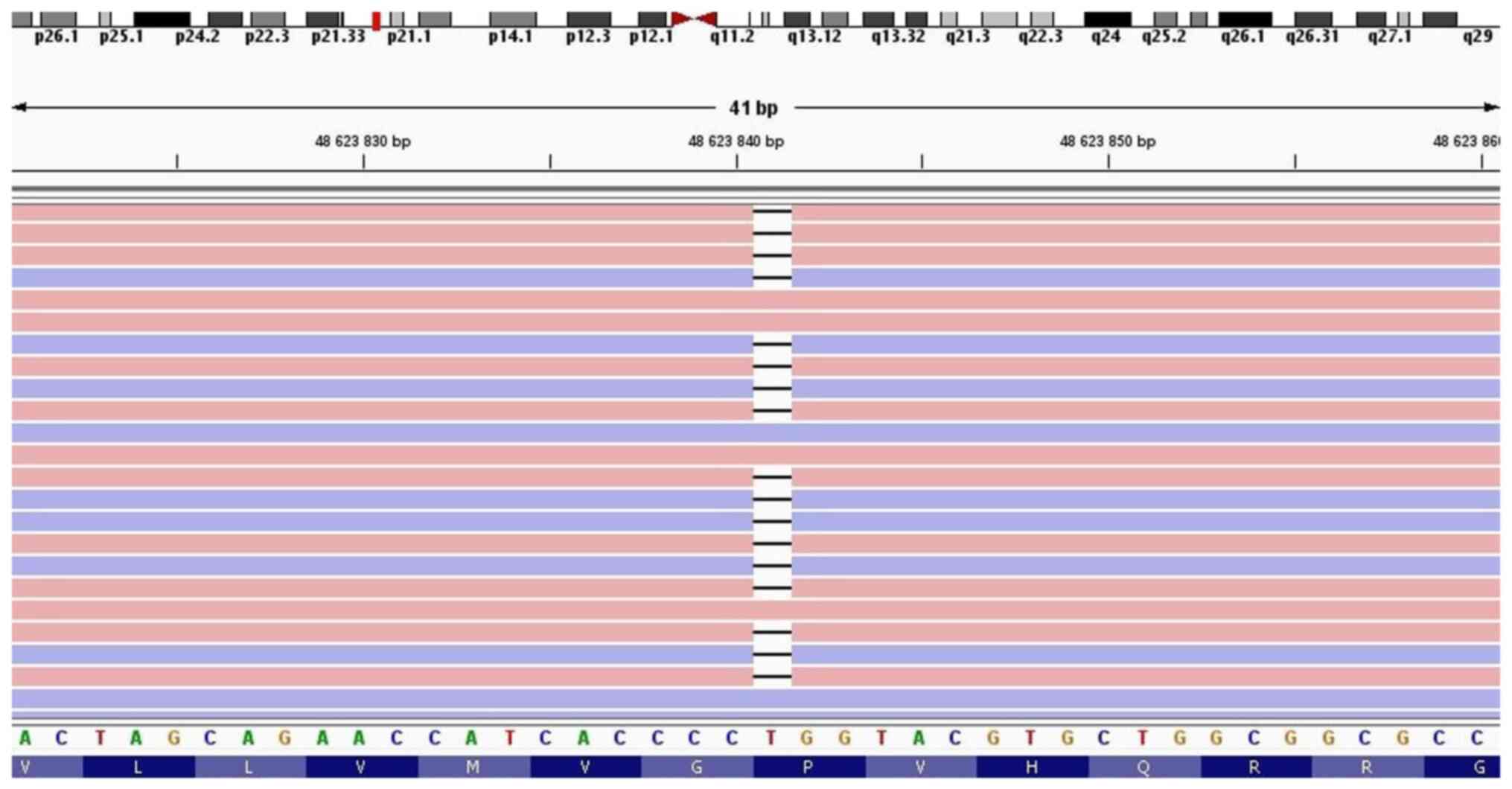Autosomal recessive type of dystrophic epidermolysis bullosa with a novel variant in the COL7A1 gene
- Authors:
- Published online on: September 11, 2024 https://doi.org/10.3892/br.2024.1855
- Article Number: 167
-
Copyright: © Nikolova et al. This is an open access article distributed under the terms of Creative Commons Attribution License.
Abstract
Introduction
The term epidermolysis bullosa (EB) encompasses an inherited clinically heterogenous group of skin conditions with a frequency of 1 in 17,000 live births (1). At least 20 different genes are associated with the diagnosis of EB, which displays profound genetic heterogeneity, further emphasized by the phenomenon of one gene leading to both autosomal-dominant and autosomal-recessive pattern inheritance with different phenotypes (2,3). The involved genes encode structural proteins, essential for intraepidermal adhesion, dermo-epidermal anchorage and skin integrity (3,4). Thus, the main clinical symptom is mechanical skin fragility presenting as mucocutaneous blistering, erosions and ulceration caused by minimal trauma or friction (5). Extracutaneous manifestation (oral, oesophageal, tracheal, genitourinary and ocular mucous membranes) has also been documented. According to the most recent consensus reclassification from 2020, the 4 main types of EB based on the lesions' location are EB simplex, junctional EB, dystrophic EB (DEB) and Kindler's EB (4). Currently, the most effective diagnostic approach for EB includes transmission electron microscopy and immunofluorescence antigen mapping of affected skin, along with DNA mutational analysis. The genetic test is a particularly important component of the diagnostic process for diagnostic confirmation (with a subtype), as it also provides the basis for proper genetic counseling and allows the application of prenatal diagnosis. At present, next-generation sequencing (NGS) is considered the preferable strategy, as it offers the ability to screen for multiple sequence variations and is less expensive (5).
The current study presents a case report of a female patient with a clinical diagnosis of dystrophic epidermolysis bullosa, identifying a novel variant in the type VII collagen α1 chain (COL7A1) gene.
Materials and methods
Patient
A 17-year-old female patient was referred by a dermatology specialist to the Genomic Laboratory of the Center of Competence, Medical University Pleven (Pleven, Bulgaria), for genetic testing and genetic counseling in June 2022. After obtaining informed consent from the patient's parents, blood samples were derived (in EDTA plastic tubes) from the patient and the patient's parents.
Germline pathogenic variant detection
Following the manufacturer's protocol, genomic DNA was extracted from each sample with the MagCore Genomic DNA Whole blood kit (MagCore®). Genetic testing of the patient and the patient's parents was performed by NGS. The TruSight One Expanded panel (Illumina. Inc.) was employed to prepare a library according to the manufacturer's protocol. The panel contained oligo probes for exons and exon-intron boundaries of 6,699 genes associated with single-gene disorders. The procedures were conducted following the manufacturer's instructions. Qualified libraries were sequenced using the Illumina NextSeq 550 platform with a 2x150 bp configuration (Illumina. Inc.), aligning the reads to the hg19 reference human genome (6). Data output files in gVCF format were entered into BaseSpace Variant Interpreter (Illumina. Inc.). Custom filters (minimum read depth of 20x per variant and excluded silent variants) were created and applied to improve variant annotation and interpretation. The five-tier terminology system of the American College of Medical Genetics and Genomics (7) was used for variant classification as follows: Pathogenic, likely pathogenic, variant of unknown clinical significance, likely benign and benign. The variants automatically annotated by the software were manually checked in the primary human genome databases ClinVar (www.ncbi.nlm.noh.gov/clinvar), dbSNP (www.ncbi.nlm.noh.gov/projrct/SNP) and Ensembl (http://www.ensembl.org).
Results
Clinical data
The patient had been diagnosed with EB at birth. According to the patient's history, during the first days after birth, the following lesions had appeared: Vesicular rash on the feet's dorsal surface, large bulla on the third and fourth finger of the left hand, and vesicles on the lower lip and tongue. A skin biopsy was performed on the third day after delivery for histopathological evaluation. The results from the latter were as follows: Subepidermal peeling of the epidermis with severe hyperkeratosis, the granular layer was composed of by one cell row; periodic acid-Schiff staining showed parts of the basement membrane. The condition displayed a chronic manifestation with a daily appearance of new vesicles, which, after bursting, transformed into erosions that tended to heal for 7-10 days and eventually evolved into white scars. The predominantly affected areas were the palms, feet, elbows and knees. Due to the formation of vesicles under the nails, the latter had fallen off completely on all of the toes and partially on the fingers, including the right thumb and index finger and left index and middle finger. The patient self-reported the occasional appearance of erosions in the oral cavity (tongue, gingival mucosa), which does not interfere with proper eating habits. The patient complained of difficulties swallowing, which had started a few months ago. X-ray examination indicated no oesophageal stenosis. The last dermatology examination revealed blisters with clear content involving the dorsal and palmar surfaces of the fingers, palms, feet, toes, elbows and knees (Fig. 1). There were single erosions on the gums and back of the tongue. The fingernails were dystrophic (Fig. 2) and both toes of both feet were with anonychia. There were no pathological changes involving the scalp.
Genetic testing results
NGS testing of the patient detected two clinically significant variants in the COL7A1 gene in a compound heterozygous state: c.6022C>T p.(Arg2008Cys) (NM_000094.3) (Fig. 3) and c.3474del p.(Val1160Ter) (NM_000094.3) (Fig. 4). The first one c.6022C>T is a missense variant in which the amino acid arginine (basic and polar) is substituted by cysteine (neutral and slightly polar) in codon 6,022. According to the ClinVar database, it is observed in individuals with dystrophic epidermolysis bullosa and is classified as pathogenic. The second variant, c.3474del, is a single base deletion of thymine in 3,474th position of the nucleotide sequence. Although expected to result in a frameshift, the amino acids Pro1158 and Gly1159 are not altered. The variant leads to the formation of a premature translational stop signal situated on exon 26. It has not been reported yet in the ClinVar database and is classified as likely pathogenic. Segregation analysis of the patient's parents revealed the c.6022C>T p.(Arg2008Cys) variant (COL7A1 gene) in a heterozygous state in the father and the c.3474del p.(Val1160Ter) variant in a heterozygous state in the mother. Thus, the parental origin of each COL7A1 variant in the patient was identified.
Discussion
DEB is the second most common type of EB, accounting for 30% of all cases (8). It can be inherited in an autosomal-dominant and autosomal-recessive manner. Both modes of inheritance are attributed to mutations in the COL7A1 gene, which encodes type VII collagen. The latter is an essential component of the anchoring fibrils and is responsible for epidermal basement membrane attachment to the dermal extracellular matrix proteins (9). Thus, the anchoring fibrils in patients with DEB are morphologically altered and lead to sub-lamina densa plane of tissue separation (10). The clinical manifestation exhibits great variability-from isolated nail dystrophy through to mild localized skin blistering to generalized blistering with extracutaneous involvement (11). The dominant subtype of DEB (DDEB) tends to exhibit less severe symptoms. Typical manifestations include blistering limited to hands, feet, knees, elbows associated with milia, atrophic scarring and nail dystrophy. Еxtracutaneous involvement is rare (12). Recessive DEB (RDEB) is less prevalent (1). The most common RDEB subtypes are the severe generalized type (formerly known as Hallopeau-Siemens) and intermediate RDEB (formerly known as non-Hallopeau-Siemens) (13). Severe RDEB manifests as congenital widespread skin blistering resulting in extensive scarring with pseudosyndactyly, alopecia, extracutaneous involvement such as corneal abrasions, mucous membrane blistering, oesophageal strictures, kidney problems and cardiomyopathy (13,14). Intermediate RDEB exhibits less severe blistering with oral, dental, hair and nail changes (14,15). Extracutaneous complications and pseudosyndactyly are less common (16). Both subtypes are associated with an increased risk of squamous cell carcinoma (15). The COL7A1 gene displays great allelic heterogeneity, as >800 genetic variants have been documented (17). It is difficult to define clear genotype-phenotype correlations, given the massive number of listed pathogenic variants and the clinical overlapping among DEB subtypes.
However, certain patterns stand out. Multiple mutations occur in exons 73-75, where 75% of DDEB pathogenic variants reside. DDEB is predominantly a result of glycine substitutions within the triple helix of the COL7A1 gene, which affects the stability of fibrils involved in dermo-epidermal anchorage (10,18). Severe RDEB is generally associated with premature termination codon (PTC) in both COL7A1 alleles due to nonsense, frameshift and splice-site mutations, leading to an insufficiency or a total lack of production of type VII collagen. Intermediate RDEB results from compound heterozygosity of the PTC variant on one allele and missense variant on the other or simultaneous presence of two missense variants on both alleles, i.e. at least one missense variant in the COL7A1 gene is always present. The expected outcome is the production of somewhat functional but abnormal type VII collagen (10,14). Clinical manifestation of DDEB and intermediate RDEB tends to be indistinguishable, posing diagnostic difficulties, particularly if there is no family history of EB (19).
In the presented case, the patient was assigned a diagnosis of DEB. There was no family history of similar skin conditions. The presented manifestation was relatively mild and classifying it preliminarily as dominant or recessive was difficult. Therefore, a segregation approach was considered most suitable for diagnostic precision-the patient and the patient's parents were simultaneously tested via NGS. The sequence data analysis revealed a compound heterozygous state in the patient's COL7A1 gene associated with the recessive form of DEB. Segregation analysis of the patient's parents further revealed their heterozygous carrier status and thus established the parental origin of both COL7A1 variants. The paternal variant was found to be c.6022C>T p.(Arg2008Cys). It is a missense located in exon 73 that leads to substitution of the amino acid arginine (basic and polar) by cysteine (neutral and slightly polar) at codon 2,008 of the COL7A1 protein. The Arg2008 amino acid is considered to be clinically significant. Reported variants that disrupt it have been classified as pathogenic. In silico analysis shows that the variant has a deleterious effect on the protein encoded by the COL7A1 gene. It has been reported in individuals affected by DEB (https://www.ncbi.nlm.nih.gov/clinvar/variation/522791/). According to the Genome Aggregation Database (GnomAD; https://gnomad.broadinstitute.org/), the frequency of the c.6022C>T p.(Arg2008Cys) variant regarding the non-Finnish European population is 0.000009. Based on the American College of Medical Genetics and Genomics (ACMG) guidelines (7), it was classified as pathogenic. The variant of maternal origin was found to be c.3474del p.(Val1160Ter). It is a novel one that had not been identified before the analysis. Its frequency is unknown as it is absent from the GnomAD database. The variant is a deletion of a single nucleotide that leads to the formation of a PTC in exon 26, out of 118 exons. It is expected to result in an absent or truncated protein product. According to the ACMG guidelines, it was predicted to be likely pathogenic.
In agreement with the literature data, the case presents as an RDEB with a milder manifestation associated with a missense and a PTC variant in a compound heterozygous state. The missense mutation is situated in exon 73, even though the type of DEB is not dominant. The inconclusive phenotype and lack of family history necessitated DNA testing to establish the genetic origin of DEB in the patient along with the right pattern of inheritance. Not only did it provide an exact genetic diagnosis, but it also allowed for informed reproductive choices to be undertaken within the family. Establishing the carrier status of patients' parents for variants in the COL7A1 gene determines a 25% risk for each of their subsequent pregnancies to end up with an affected offspring. Concerning the optimization of patient reproduction, it is recommended that the patient's future partner is tested for their COL7A1 gene carrier status. The latter is necessary to estimate the risk for an affected offspring. If no pathogenic variants in the COL7A1 gene of the partner are detected, the risk is virtually zero. Detection of carrier status determines a 50% risk for an affected offspring.
In conclusion, the presented case with detected variants in the COL7A1 gene may contribute to the establishment of more certain genotype-phenotype correlations. The overlapping of symptoms in different subtypes of DEB requires genetic testing via NGS to determine the exact inheritance pattern. The latter is essential information for accurate genetic counseling regarding the subsequent reproduction of the patients' parents and the patients' own reproduction.
Acknowledgements
The authors would like to thank Mrs. Yanka Tzvetanova, a philologist and a senior teacher of English for Medical Purposes and General English, who provided assistance in editing the language of the current paper.
Funding
Funding: This study was supported by the European Regional Development Fund with the leading organization Medical University Pleven (grant no. BG05M2OP001-1.002-0010-C01).
Availability of data and materials
The NGS datasets generated and/or analyzed during the current study are available in the ClinVar repository (https://www.ncbi.nlm.nih.gov/clinvar/variation/3257728/). The other data generated in the present study are included in the figures and/or tables of this article.
Authors' contributions
IAY recruited the patient. SEN, ZBK, IAY and PPV collected clinical and biological data. SEN and ZBK performed the molecular analysis. IAY was responsible for the diagnosis and treatment of the patient. ZBK analyzed the data. SEN, ZBK and KSK were involved in the writing and revision of the manuscript. SEN and PPV reviewed and revised the manuscript. All authors have read and approved the final manuscript. SEN and ZBK confirm the authenticity of all the raw data.
Ethics approval and consent to participate
This study was approved by the Ethics Commission of the Medical University Pleven (Pleven, Bulgaria). The patient's parents provided written informed consent regarding their own participation in the study along with the participation of the patient (their daughter), who was <18 years of age at the time of the analysis.
Patient consent for publication
Written informed consent for the publication of their data was obtained from the patient's parents.
Competing interests
The authors have no competing interests to declare.
References
|
Siañez-González C, Pezoa-Jares R and Salas-Alanis JC: Congenital epidermolysis bullosa: A review. Actas Dermosifiliogr. 100:842–856. 2009.PubMed/NCBI(In Spanish). | |
|
Prodinger C, Reichelt J, Bauer JW and Laimer M: Epidermolysis bullosa: Advances in research and treatment. Exp Dermatol. 28:1176–1189. 2019.PubMed/NCBI View Article : Google Scholar | |
|
Sait H, Srivastava S and Saxena D: Integrated management strategies for epidermolysis bullosa: Current insights. Int J Gen Med. 15:5133–5144. 2022.PubMed/NCBI View Article : Google Scholar | |
|
Mariath LM, Santin JT, Schuler-Faccini L and Kiszewski AE: Inherited epidermolysis bullosa: Update on the clinical and genetic aspects. An Bras Dermatol. 95:551–569. 2020.PubMed/NCBI View Article : Google Scholar | |
|
Bardhan A, Bruckner-Tuderman L, Chapple ILC, Fine JD, Harper N, Has C, Magin TM, Marinkovich MP, Marshall JF, McGrath JA, et al: Epidermolysis bullosa. Nat Rev Dis Primers. 6(78)2020.PubMed/NCBI View Article : Google Scholar | |
|
Homo sapiens genome assembly GRCh37. (n.d.). NCBI. https://www.ncbi.nlm.nih.gov/datasets/genome/GCF_000001405.13/. | |
|
Richards S, Aziz N, Bale S, Bick D, Das S, Gastier-Foster J, Grody WW, Hegde M, Lyon E, Spector E, et al: Standards and guidelines for the interpretation of sequence variants: A joint consensus recommendation of the American College of Medical Genetics and genomics and the association for molecular pathology. Genet Med. 17:405–424. 2015.PubMed/NCBI View Article : Google Scholar | |
|
Hou PC, Del Agua N, Lwin SM, Hsu CK and McGrath JA: Innovations in the treatment of dystrophic epidermolysis bullosa (DEB): Current landscape and prospects. Ther Clin Risk Manag. 19:455–473. 2023.PubMed/NCBI View Article : Google Scholar | |
|
Nyström A, Bruckner-Tuderman L and Kiritsi D: Dystrophic epidermolysis bullosa: Secondary disease mechanisms and disease modifiers. Front Genet. 12(737272)2021.PubMed/NCBI View Article : Google Scholar | |
|
Chung HJ and Uitto J: Type VII collagen: the anchoring fibril protein at fault in dystrophic epidermolysis bullosa. Dermatol Clin. 28:93–105. 2010.PubMed/NCBI View Article : Google Scholar | |
|
Dang N and Murrell DF: Mutation analysis and characterization of COL7A1 mutations in dystrophic epidermolysis bullosa. Exp Dermatol. 17:553–568. 2008.PubMed/NCBI View Article : Google Scholar | |
|
Sawka E and Funk T: Dominant dystrophic epidermolysis bullosa with congenital absence of skin and brachydactyly of the great toes. Pediatr Dermatol. 38:1251–1254. 2021.PubMed/NCBI View Article : Google Scholar | |
|
Shinkuma S: Dystrophic epidermolysis bullosa: A review. Clin Cosmet Investig Dermatol. 8:275–284. 2015.PubMed/NCBI View Article : Google Scholar | |
|
Eichstadt S, Tang JY, Solis DC, Siprashvili Z, Marinkovich MP, Whitehead N, Schu M, Fang F, Erickson SW, Ritchey ME, et al: From clinical phenotype to genotypic modelling: Incidence and prevalence of recessive dystrophic epidermolysis bullosa (RDEB). Clin Cosmet Investig Dermatol. 12:933–942. 2019.PubMed/NCBI View Article : Google Scholar | |
|
Laimer M, Prodinger C and Bauer JW: Hereditary epidermolysis bullosa. J Dtsch Dermatol Ges. 13:1125–1133. 2015.PubMed/NCBI View Article : Google Scholar | |
|
Fine JD: Inherited epidermolysis bullosa. Orphanet J Rare Dis. 5(12)2010.PubMed/NCBI View Article : Google Scholar | |
|
Ma THT, Luong TLA, Hoang TL, Nguyen TTH, Vu TH, Tran VK, Nguyen DB, Trieu TS, Nguyen HH, Nong VH and Nguyen DT: Novel and very rare causative variants in the COL7A1 gene of Vietnamese patients with recessive dystrophic epidermolysis bullosa revealed by whole-exome sequencing. Mol Genet Genomic Med. 9(e1748)2021.PubMed/NCBI View Article : Google Scholar | |
|
Yan Y, Meng Z, Hao S, Wang F, Jin X, Sun D, Gao H and Ma X: Five novel COL7A1 gene mutations in three Chinese patients with recessive dystrophic epidermolysis bullosa. Ann Clin Lab Sci. 48:100–105. 2018.PubMed/NCBI | |
|
Varki R, Sadowski S, Uitto J and Pfendner E: Epidermolysis bullosa. II. Type VII collagen mutations and phenotype-genotype correlations in the dystrophic subtypes. J Med Genet. 44:181–192. 2007.PubMed/NCBI View Article : Google Scholar |













